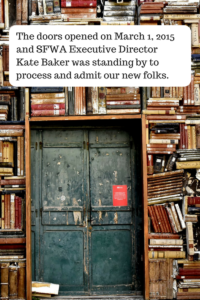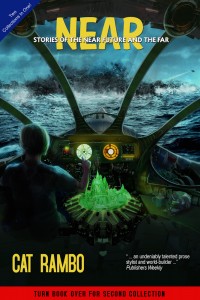This third of a four part series about the Science Fiction and Fantasy Writers of America’s decision to admit independently published writers talks about the first wave of independent members and SFWA’s efforts to add value for those members. Here is Part One: History of the Organization and Part Two: Bringing in the Indies.
 Swinging the Doors Open to Independent Writers
Swinging the Doors Open to Independent Writers
The doors opened on March 1, 2015 and SFWA Executive Director Kate Baker was standing by to process and admit our new folks. This gave us a chance to observe the new criteria that the Board had been working on for so long in action with a mind for what sort of refinements might be necessary further on down the line in order to make SFWA even more welcoming to independent and small press writers.
I was glad we’d prepped the message boards. The new forums were immediately put to use and introductions made, with plenty of delighted welcomes. There was – in my perception – no contention, only enthusiasm.
Here’s a videocast M.C.A. Hogarth did aimed at indie writers evaluating whether or not to try SFWA:
Some statistics for the number-minded:
- We admitted twelve new members in that first wave, and there’s been a steady influx since. At the same time, existing members that had independent published experience felt more empowered to step forward and share their knowledge.
- According to the recent membership survey, 14.10% of the current membership identifies as indie, with another 37.57% considering themselves hybrid.
- Only a small percentage (less than 5%) derives more than 50% of their income from crowdfunding.
All My Expectations of Indie SFWA Members Confirmed
As I and others had argued repeatedly, the change did not result in an influx of unqualified, affluent hobbyists trying to buy their way into SFWA, and we could, finally, put that particular straw man to rest and play taps while other straw folk were being assembled in the background.
As you can see by the numbers, it wasn’t a massive surge, but a solid number. For some people it was part of a lifelong dream. For others, it was a cautious exploration of just what SFWA had to offer them. More than anything else, these were pragmatic, working writers. In a thread on the discussion boards, people began to share their sales number in a revelatory and instructive way that emphasized what a smart move for SFWA this had been. I still inist one of the smartest moves that happened during my time with the board.
I kept meeting new members at cons, to my pleasure and delight. We began to offer more SFWA-focused programming at conventions, such as a panel about What SFWA Offers at GenCon, Norwescon, the Nebulas (that was a no-brainer), and others.
Unexpected Results from the Indie Wave
- We found we’d done something groundbreaking without realizing it: become the first organization to allow crowdfunded projects to qualify. The question of net versus had been a subject of much discussion during the Board’s conversation, to the point where the overall category was in jeopardy, so I was happy to discover pushing to keep it alive had been useful.
- Rarely did people have to combine sales in order to prove they’d hit the 3k in one year mark. Instead it was usually a question of “Do you want my sales from Amazon or Kobo? (or something else).
- A delightful surge of volunteers and new energy should have been expected, but it took me by surprise nonetheless.
New Members Benefits — And Vice Versa
With that surge in volunteer energy came a lot of new stuff, primarily driven by Vice President Maggie Hogarth. People entered wanting to not just to connect with other members but to add their energy to the organization and help it grow to meet their needs.
Among them:
- The New Release Newsletter. Taken from the description: “The newsletter goes out every two months, and feature science fiction and fantasy new back-list re-releases from SFWA members, including books, stories, games, and other creations.” (SFWA members can sign up for it here. Releases that are announced should be from the month before or the month after the newsletter goes out.) That newsletter goes out to close to 1000 subscribers and has an above-average open rate.
- The Partners Program has been more successful in some areas than others, but overall it’s tried to build connections with industry contacts. Particularly successful ones include BookBub, HumbleBundle, Kickstarter, Kobo, and Storybundle. Today we launch one of the results of that, the second Storybundle we’ve done, this time the SFWA Fantasy Bundle (that link will go live Wednesday morning!). The Sci-Fi bundle earlier this year netted each of its writers a nice chunk of money, around $900, along with the curator’s payment, an equivalent amount which I donated to SFWA, as I’ll do again with this one. Next year our Self-Publishing Committee will take over running this program, and there will be three bundles altogether.
- The Netgalley Program was a long long time coming and something I don’t know would have happened without Maggie lending her voice to insist this was something useful for our members, but it’s now something people frequently ask me about. I stole the idea from Broad Universe, which was to buy a membership that our members could use for individual books for a substantially cheaper cost than getting such a membership on their own. Here’s how to use it to promote a book.
- The SFWA Star Project was a cool effort (and remains one) but it’s been a bit of an uneven project. Originally proposed by Rob Balder, it used a small budget to promote and support worthy crowd-funded projects. Material rewards gained by supporting a Kickstarter go to SFWA’s fundraisers to be used there.
- Expanded Nebula Programming was a natural outgrowth of the new energy, and programming tried to bring in both partners that year as well as create programming aimed at the new members. One lesson learned that first year was that the usual basic level stuff was not what people wanted, but rather in-depth looks at specific aspects of the industry and how to use SFWA’s services to the most benefit. Another was that we needed to figure out a new bookstore policy in order to accommodate everyone.
Nebula programming for the indies would be an issue both that year and the following one, with many indies feeling they were unrepresented and saying so on the discussion forums. The second year seemed to me to be partly an issue of perception and bad framing rather than actual lack: while many of the panels were aimed at indies as well as hybrid and trad pubbers, they were not marked as being of interest to indies. To my mind, they have progressed significantly each year: for me last year’s highlights included the mentoring program, the chance to hear experts talking about their wide range of expertise in office, and the fact that we managed to give everyone, including the indies, a way to have their books for sale there at the events. (Thank you Sean Wallace!)
Many existing services were already there for the new members such as the Featured Book/Artist program, the Nebula Awards, and appearances at events such as WorldCon, the Baltimore Book Festival, GenCon, and others. Other new things were applicable to all sides, such as the SFWA Speakers Bureau, introduced in early 2016 or the emerging Grants Program. I tried to make sure that indies were represented on the SFWA Recommended Reading List, and continue to do so, as do a number of other people.
All in all – things were swell, and continue to be so.
Next time, in Part Four (the final one) — what does the future hold in store? Includes talking about data from the recent SFWA member survey as well as revelation of at least one cool project designed to help people reading novels for all yearly awards, including the Nebulas, Hugos, Dragon, World Fantasy, among others. *cue mysterious music and exit*
#sfwapro





